by Scott Smith | Contributing Editor
The growth of competitive shooting has taken the industry by storm. It was not all that long ago that everything was geared to be Tactical Ted or Tactical Sally. We were hanging more stuff on AR15/M4 platforms than those who are actually in harm’s way. One day folks realized they really do not need to have every gadget known to man hanging off of a seven pound rifle that did little to improve our skills with it. Thanks to the late Pat Rogers (RIP Marine) and his EAG Carbine built by Bravo Company on the training side of the industry and the growth of Three-gun competition, folks realized you do not need all this stuff. What you need is a gear that works, firearms that are accurate and, of course, to get out and practice with your gear.
This year we are going to look at some clothing, accessories and firearms that help your game. Fear not; we are not going to kit you up like you are deploying with the 18th Airborne Corps to Bagram. You will find that the gear is built to be comfortable, durable and not break the bank.
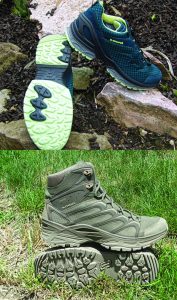
Lowa’s Innox TF GTX and Onyx GTX to keep your feet supported and dry on the range, in the field or around town.
We are going to start from the ground up with footwear from Lowa (Phone: 203-353-0116; Online: lowaboots.com). Long known for hard use mountaineering boots, Lowa has moved into the trail running and lighter hiker boot market. This move has brought footwear built to survive climbing in the Alps to the shooting community. In plain terms you get footwear that is tough, waterproof (if you choose Gore-tex), wears like iron and is comfortable. The same cannot be said of many of the shoes/boots you might see competitors wearing. When I have asked folks why they spend big bucks on shoes that are not waterproof and wear poorly, the answer is: traction. The spikes and rubber nubs give better traction. Having worn Lowa boots in all conditions, I can tell you firsthand their boots give you near mountain-goat traction.
We looked at two pairs of Lowa boots for this article. For men we chose the Innox Mid GTX TF at $220 and ladies the Onyx GTX Lo at $185. These two boots feel like your favorite pair of running shoes that have been built on steroids.
Aside from their Gore-Tex lining what sets these two boots apart from other “trail running” type shoes is the MONOWRAP Midsole/frame. The MONOWRAP, as the name implies, wraps the foot and is fused to the midsole so you have a stable lightweight shoe. When traversing the hills of The Pro Gun Club in Boulder City you grow to appreciate the stability Innox or Onyx boots offer. You will notice the Innox MONOWRAP is exposed while the Innox’s is in the upper. This is because the Innox has a heavier wrap which, if imbedded in fabric, could compromise its integrity.
I wore a pair of the Innox boots last year to shoot Three-gun and USPSA matches in hot dry conditions to wet, cold and muddy conditions. They kept my feet dry and, more importantly with my bionic knees, kept me stable in these wide ranging conditions, thanks to the NXT sole. This sole is self-cleaning, affords solid 360 degree traction and wears well, something other “trail running” soles do not. The X Terrain outsole on the Onyx performs well on all terrains and is designed to give you a natural roll with each step. Lisa put her Onyx’s to the test working with FEMA in Texas doing disaster relief. She was hiking all over for upwards of 12 hours a day and said her feet never ached, other than just being worn out.
Another feature of Innox and Onyx families of shoes is they look as good as they perform. These boots do not scream “gun person”; they look like any other venture running shoe; even the black models. If you are looking for a boot that is truly all-round footwear for use on the clays range, Three-gun, duty, etc. Lowa’s Innox and Onyx series will be tough to beat. Your feet and back will thank you for supportive protective footwear.
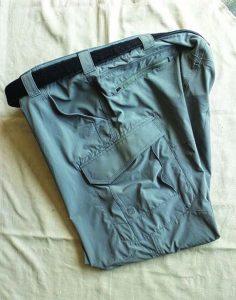
5.11 Tactical’s Traverse pants showing all the pockets and the belt loops for the AA PCB that fits perfectly, making these an ideal competition set up.
We all know you have to look good when shooting, that’s where 5.11 Tactical’s (Phone: 866-451-1726; Online: 511tacitcal.com) Traverse comes in. Before you balk at the $89.99 price tag, let’s see the features of these pants. First they come in black, khaki, storm (grey) and tundra (olive green). These colors pretty much will look good with any color shirt. Second is the single weave stretch fabric with its gusseted crotch, double layer knees, and bar tacked seams. Third is the number of pockets; ten to pack and stuff with most anything you need on match day. Last is the 1¾” belt loops; they are spaced and large enough to fit all but the heaviest belt.
The Traverse has more of a fashion BDU look than a military look. This means the cargo pockets with their internal magazine pouches lay flat with two 20-round magazines in them. The hip pockets are zipper slash pockets instead of scoop pockets. For cooling the front slash pockets are mesh. It may not sound like this makes a difference but this does vent body heat. 5.11 reinforces the back of the hem of the legs to reduce wear of the legs from your boots. 511 added a feature from business suits, the double button waist closure, ensuring your pants won’t pop open when bending, hefting a load or other strenuous activity that expands your waist.
I wore these pants for a few road trips; thanks to the gusseted crotch and articulated knees they were comfortable. On the range they were perfect. The belt loops are placed properly for holster placement and the material did not snag when wearing my DAA Premium Competition Belt. I have seen other pants made from stretch fabrics pill and snag on this hook/loop material. Not only will the material hold up to the hook material but even nasty range crud consisting of grass stains, sweat and mud washes out. If you are looking for pants that will hold up to Three-gun competition, dry quickly and look good enough for casual wear, 5.11 Tactical’s Traverse has you covered.
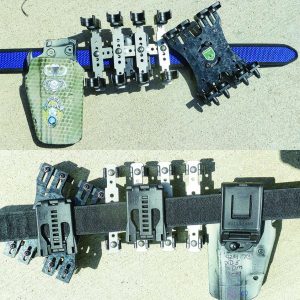
These photos show that the AA Premium Competition Belt fits various mounting brackets, something other competition belts do not do.
This year I started using a DAA Premium Competition Belt from Competitive Edge Dynamics (Phone: 888-628-3233; Online: cedhk.com) as my primary belt for USPSA. This belt retails at $59.95 for the inner/outer belt package. The Premium Competition Belt is less bulky, thinner and more rigid than other competition belts on the market. When using various mounting systems having thinner belt ensures they will fit and lock properly.
What drew me to the Premium Competition Belt was its width and thickness. Not all 1½” belts are created equal. While they are 1½” the thickness varies. Tek-Loks and other systems do not secure well if the belt is too thick, if at all. The folks at CED told me this belt was built so all of the mounting systems work well on this belt. I am pleased to say they were right. I tried various “belt loops”, clips, Tek-Loks, etc. and they all fit properly.
The key to a belt system fitting properly is the inner belt. It seems they come in two versions; flimsy or too rigid. Either way, over the course of a match, these allow your gear to shift because the inner belt is not conforming to your hips, which for women can be really annoying and uncomfortable. The way this liner is laminated gives you the comfort and hip-hugging fit of a light belt while being semi-rigid. When mated with the outer PCB you have a rock solid belt that will secure your gear for a USPSA or the harsh use of a Three-gun field course. I like the DAA Premium Competition Belt sold by Competitive Edge Dynamics well enough that I use one for training and competition. That’s the best recommendation I can offer on gear.
Two other pieces of kit I have been using for Three-gun this year are shotgun shell caddies from Taccom (Online: taccom3g.com) and Invictus Practical (Online: invictuspractical.com). These caddies can be mounted with Safariland’s ELS or a Tek-Loks. Since I was using the DAA PCB, my samples were mounted with Tek-Loks.
First up is the 8D from Invictus Practical. This is a dedicated load two carrier that gives you several options on spacing the shell holders on a bendable bracket to fit your body. This unit has four racks to hold your shells that can be placed on the mounting bar spaced how they work best for you. Having them evenly spaced seemed to be the easiest configuration for me two shells at a time. I did bend the frame to better fit my hip; this also gives easier access to the dual load. Invictus’ mounting system allows you to set the rack angles to fit you—seems like there could be a hundred ways to mount the 8D. With additional hardware you can increase the capacity, making this an expandable system.
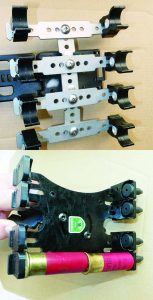
When you need versatile competition shotgun shell carriers, you will be hard pressed to beat the versatility of Invictus Practical’s 8D (top) or the speed of the Quadload MG, showing the magnets to lock the shells in, even when upside down.
Taccom’s 8Up Quadload MG is one of the more unique carriers on the market. The top shells are secured by small magnets that hold the shells in place by “locking” onto the primers. The bottom shells are held in place by friction and gentle force on the top shells. I was skeptical about the shells staying when loaded into the QMG. What I found was, unless you violently shake the Quadload MG the shells are secure. This quadloader is fast and smooth, especially if you angle the carrier so you scoop the shells up instead of pulling them sideways. The shell holders are adjustable to fit both 2¾” and 3” shells; this will also adjust the tension on the shells to ensure they don’t shake loose.
I have used both the 8D and the Quadload MG during competition and practice and find both to be excellent shotgun shell carriers. The MG with its magnets and rubber pressure pads holds the shells securely until you grab them. The 8D because of its vast adjustability makes it ideal for stages that require a variety of loads. You can feel and see the loads, something you cannot do with other carriers. Over the last couple of years I have seen many competitors using both Taccom and Invictus Practical carriers because they work well and both companies give great customer service. Check out both their websites you will find shotgun shell carriers to fit all Three-gun and action shotgun needs.
These loaders were used to feed the new Predator Tactical 3Gun Shotgun (Phone: 602-652-2864; Online: predatortactical.com). This shotgun is the brain child of champion shooter Matt Burkett. Matt wanted to offer competitors a shotgun that is truly match ready from the box. Many shotguns on the market say they are “race ready,” but still need tweaking or enhancements to make them truly ready to run.
So what sets the PT3G apart from the competition? First off the shotgun is built by a small custom shop in Turkey ensuring tight quality control and, if needed, improvements can be made quickly. Before you scoff at the gun being built in Turkey, remember the Turks have been building high quality affordably priced firearms for decades. Second, Predator Tactical sells direct to customers, shipping to the FFL holder of their choice. Third, if you have an issue with the shotgun, you are dealing directly with the developer and company staff/owner. Unlike many of the big names where you are dealing with their repair center where the staff has very little vested interest in passing along issues with the gun. Predator Tactical wants their products to exceed customer expectations. Fourth, the PT3G is the only 3GunNation licensed shotgun and will be the official shotgun of American Marksman. Last the PT3G is truly race ready; let’s see why.
The first thing that Predator Tactical does is ship the gun with five choke tubes; IC, IM, S, F, M, which cover most competition and field needs. They are color coded so you do not have to look for hash marks on each tube or clean off dirty tubes to see the markings. To ensure the tubes are secure in the barrel you get a wrench and a case to protect them from damage.
Next you have custom sights on the rib with Truglo fiber optics. Most shotguns have just a bead, not the PT3G. There is a low mounted “rifle” sight in the rib so you can accurately aim slugs and buckshot on those long range targets. On 80 yard steel, I was able to deliver first shot hits nearly every time; the operator must let the sights settle before firing the next round.
Factory standard features on the PT3G are extended safety, oversized charging handle and extended bolt release. All of these make operating the shotgun easier and faster. Predator Tactical also enlarges the loading port and properly sets the lifter so you can easily dual or quad load. From what I have seen, this is something all but true custom shop competition do not do. This work will easily set you back a couple hundred dollars. A feature not found on any other shotgun is the Dry Fire Rapid Practice Release that allows you to empty the gun without racking the bolt.
Many Three-gun matches have night/low light stages requiring a light. You will find a Picatinny rail molded into the leading edge of the forearm. All of the weapons lights I have mounted securely to this rail. I mention this because many polymer rails require adjusting when a light is set to fit a metal rail. Predator Tactical made sure their rail’s size is that of a Picatinny rail.
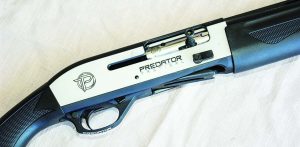
You can see the extended safety, charging handle and bolt release of the Burkett Predator Tactical 3Gun Shotgun.
To get all of the standard features of the PT3G on your supposedly competition ready shotgun you will lighten your wallet by several hundred dollars over the cost of your shotgun. The Burkett Predator Tactical 3Gun Shotgun will set you back $1495 for the polymer version while the Circassian Turkish Walnut will be $1995.
When you open the box and you see a five-shot shotgun, don’t have a fit; there is an extension tube in the box. Installing it would make the gun too long to ship and it has to be end-user installed because of importation restrictions. Don’t ask, it’s a government thing. You will need to remove the protective small threads on the extended tube and it will screw into the provided cap. I suggest installing the spring into the magazine extension tube first so you can control the bulk of the spring. This extension will bring the capacity of the PT3G to ten 2¾” shells in the tube, 9 if you run 3” with an untrimmed spring.
I ran nearly a thousand rounds through this shotgun over three weeks for testing. The only issue the shotgun had was the operator attempting to load the brass end of the shell into the chamber first. As we said in the Army, that’s a No Go. Ammunition wise this gun ran on the cheapest ammunition I could find, the most expensive trap/skeet loads, 00 buck of all varieties, standard and reduced recoil slugs and even several decades old paper hulled “high brass” magnums. While the gun will run on virtually everything, loads in the 1,150-1,200 feet per second are what is recommended. This is generally plenty fast enough to bring down steel, tighten the restriction of the tube at longer ranges.
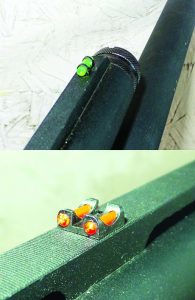
This is the low mounted rifle sight (bottom) and front sight of the PT3G with custom mounts securing Truglo fiber optics.
Some of the testing I did with the PT3G was to see if I could induce stoppages from simply running the gun as fast as I could shoot it and the receiver became too hot to handle. This has caused some of the most popular guns to hiccup or get sluggish; not so with this one. I will tell you this test wears the operator out, and is one I do not suggest you do to your gun.
As I had mentioned the PT3G has custom Truglo low profile rifle sights. This means you can actually aim the gun when shooting slugs or buck shot. My gun did not show a preference for slugs. With the modified choke tube installed, all the varieties I shot consistently hit approximately 2” low at fifty yards, centered. 00 buckshot was dead on at 25 yards with all pellets staying in the “A” zone USPSA target. I strongly suggest you try several varieties of slugs to see what will give you the best accuracy and check the POA/POI out to at least 75 yards for long shots.
One thing I did find during testing was if you miss locking a shell into the magazine tube the shell comes back onto the shell bale. This can prevent many shotguns from functioning. When this happened, I pulled the trigger and the gun went bang. I intentionally induced this error several times with various loads, but it did not slow the PT3G down.
Another feature on the shotgun is its weight. It weighs 6.5 pounds empty. This makes a fast handling gun whether you use it for competition, upland hunting or as a tactical gun. You will notice I mentioned upland and tactical use, with its 22” barrel the PT3G is good for those applications as well. If the gun is used for tactical and home defense purposes the matte finished receiver is easy to find in the dark while not blinding you from reflected light.
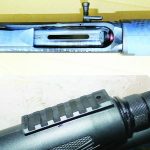
You can see the relieved loading port of the PT3G to ensure fast dual or quadloads. You will find the forearm has a Picatinny rail to mount a light for lowlight/night stages of a match.
The Matt Burkett designed, Turkish-built Predator Tactical 3Gun shotgun is one of, if not the best, values in a competition-built shotgun on the market today. I like it well enough that I am running this gun in all the major Three-gun matches I shoot. I say that not because Burkett has been a good friend for nearly 20 years, but because the PT3G is a fine shotgun. The light weight, mixed ammunition reliability, fast cycling, rifle slug accuracy and fit of the shotgun are why. The PT3G will serve new shooters and seasoned veterans, making all faster, better shooters. When you combine this with the commitment of Predator Tactical after the sale, you will be hard pressed to find a shotgun that can beat the PT3G. Contact Predator Tactical to purchase one and have it delivered to your local FFL holder. You will not be disappointed in how the gun fits, feels and shoots.
Hopefully, we have given you a few ideas for gear when shooting competition, just plinking or for daily wear when it comes to pants and shoes. Be careful in the summer heat when at the range. Be careful, be safe, have fun and remember to vote for your Right to Keep and Bear Arms.



